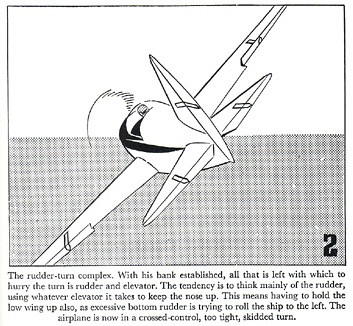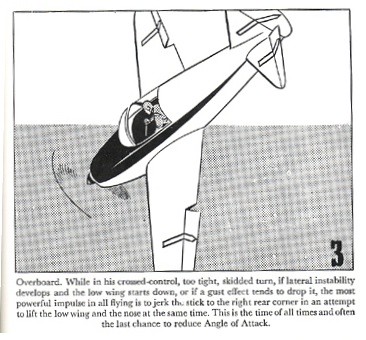Page 2 of 5
Re: Fatal(1) Evektor Harmony in Russia
Posted: Fri Nov 07, 2014 11:45 am
by drseti
CTLSi wrote:Touch and go on rough runway, flares high, bounces, kicks left foot on rudder fails to correct for torque. Climbs to treetop low. Then steps on left rudder and pulls a steep turn, slow and low and stalls. Shocking...
This is a classic example of an accident being caused by a chain of events. If you break the chain at any link, you prevent the accident. And the earlier the link you choose to break, the better.
I break this chain at its very first link, by not doing touch-and-goes. Every approach to a landing ends in either a full stop, or a go-around. I realize this is less economical for the student trying to maximize landings in a given training session. But, I am always willing to sacrifice economy in the interest of safety. (My preference is also a throwback to my taildragger days. With a conventional landing gear, the hardest part of a landing occurs after the wheels have touched. Do a go-around, and you miss out on the most important part. This is why, in a taildragger, the 90 day passenger currency requirement includes three landings
to a full stop.)
For a different perspective, see this excerpt from one of my early books:
http://avsport.org/publicat/nonfict/touchngo.htm
Re: Fatal(1) Evektor Harmony in Russia
Posted: Fri Nov 07, 2014 12:09 pm
by MrMorden
drseti wrote:
I break this chain at its very first link, by not doing touch-and-goes. Every approach to a landing ends in either a full stop, or a go-around. I realize this is less economical for the student trying to maximize landings in a given training session. But, I am always willing to sacrifice economy in the interest of safety. (My preference is also a throwback to my taildragger days. With a conventional landing gear, the hardest part of a landing occurs after the wheels have touched. Do a go-around, and you miss out on the most important part. This is why, in a taildragger, the 90 day passenger currency requirement includes three landings to a full stop.)
Hmm...this didn't really look like a touch and go to me. More like a go around initiated after the wheels touched, due to the aircraft not being aligned with the runway. The perplexing part is why the instructor allowed the turn out to the left instead of bringing the airplane back over the runway for an unobstructed climb. It was mentioned that power was reduced at some point, and that would obviously have been a serious mistake as well if that is true.
Re: Fatal(1) Evektor Harmony in Russia
Posted: Fri Nov 07, 2014 12:14 pm
by FastEddieB
Again, a response of mine to the POA thread:
Right here is where I'm pretty confident I would have been primed to rapidly lower the nose and slam in however much right rudder was required to keep the plane pointed down the runway.

I know this because I've been there many times before. I suspect most instructors who have taught in high performance planes have seen this view repeatedly as well, and are prepared to take firm action. If they weren't there's a good chance they'd no longer be among the living!
Re: Fatal(1) Evektor Harmony in Russia
Posted: Fri Nov 07, 2014 12:15 pm
by CTLSi
......
Re: Fatal(1) Evektor Harmony in Russia
Posted: Fri Nov 07, 2014 4:33 pm
by designrs
In this tragic example there was not a proper touch & go by any definition. It was a botched landing with a tragic sequence of events that were not acted on early enough, the first of which was going waaaay off the left side of the runway.
With all due and high respect to the Professor, I love touch & goes and don't see any harm in them, especially in a non-complex aircraft like my LSA. Now, I wouldn't rush a touch and go... or even commit to one on final (other than to say "maybe" touch & go). So if it's like, "I'm comfortably rolling with plenty of runway ahead, everything is lined up & very comfortable, might as well go back up again" then touch & go becomes a viable option.
Also, I've have had very productive training sessions where I do a low-pass, not intending to touch down, but the gear just brushes the runway... it becomes a touch and go!
Tailwheel and complex aircraft are another story.
Normal low-passes, landings and touch and goes all relate to the common denominator skill set of being comfortable "flying low"... there is not a big difference, given a reasonable amount of basic practical experience.
... experts and those of more experience, comments welcome!
Re: Fatal(1) Evektor Harmony in Russia
Posted: Fri Nov 07, 2014 4:54 pm
by designrs
FastEddieB wrote:

If you had enough altitude and airspeed I suppose you could get away with lowering the nose & right aileron? At this point the plane is not stalled... that came later flying over the trees.
Re: Fatal(1) Evektor Harmony in Russia
Posted: Fri Nov 07, 2014 5:11 pm
by drseti
designrs wrote:With all due and high respect to the Professor, I love touch & goes and don't see any harm in them
You are, however, a fairly experienced pilot. For you, Richard, I see no problem. Using them as a primary training tool for very low-time primary students is another matter altogether.
Re: Fatal(1) Evektor Harmony in Russia
Posted: Fri Nov 07, 2014 8:13 pm
by FastEddieB
designrs wrote:
If you had enough altitude and airspeed I suppose you could get away with lowering the nose & right aileron? At this point the plane is not stalled... that came later flying over the trees.
It is possible at that point that a coordinated turn to the right may have still been possible. So you're not wrong.
But if you zoom in on the airspeed indicator, the airspeed already appears pretty low.
The instinct I've developed in situations like this is to lower the nose and pretty much neutralize the ailerons. The main problem is the plane is yawing left and that yaw primarily needs rudder to counteract it. This instinct has been honed by many "incipient spin" exercises, and even to some extent by the Vmc drills we used to do in twins*.
Aileron away from the turn is instinctive and natural. It may even work. But if the left wing is close to the stall, trying to lift it with aileron can send the whole enterprise over the top into a spin as the left wing hits it's critical angle of attack before the right.
*I wonder if this instructor was also a multiengine instructor. His throttling back is highly unusual. About the only time it's appropriate is on a Vmc demo. Speculative, I know, but that might explain the somewhat bizarre reaction.
Re: Fatal(1) Evektor Harmony in Russia
Posted: Fri Nov 07, 2014 8:19 pm
by BrianL99
drseti wrote:designrs wrote:With all due and high respect to the Professor, I love touch & goes and don't see any harm in them
You are, however, a fairly experienced pilot. For you, Richard, I see no problem. Using them as a primary training tool for very low-time primary students is another matter altogether.
I've never understood why touch & goes have become such a staple for flight training. I have done exactly two (2) touch & goes without an instructor and one of them was on a 9000' runway.
Just my opinion, but I think they're unnecessarily risky and valueless for most solo pilots.
Re: Fatal(1) Evektor Harmony in Russia
Posted: Fri Nov 07, 2014 8:40 pm
by CTLSi
......
Re: Fatal(1) Evektor Harmony in Russia
Posted: Fri Nov 07, 2014 8:50 pm
by FastEddieB
BrianL99 wrote:
Just my opinion, but I think they're ridiculously risky...
If you feel that way, by all means do not do them!
But that sounds a lot like hyperbole to someone who's done thousands over 40 years without issue.
It starts with a normal approach and landing.
The plane then slows to taxi speed.
The pilot then performs a quick checklist or, more likely, a very brief "flow".
Then after confirming sufficient runway remaining, a normal takeoff follows.
I don't see any appreciable risk involved, or I would not do them routinely. Much less "ridiculous" risk.
But each pilot has their own individual way of weighing risks, and, again, if not comfortable with touch and goes please do not do them.
And back on topic, its not clear a touch and go was planned in this accident. Clearly one was not performed in the video - at least not intentionally!
Re: Fatal(1) Evektor Harmony in Russia
Posted: Fri Nov 07, 2014 9:07 pm
by FastEddieB
Re: Fatal(1) Evektor Harmony in Russia
Posted: Fri Nov 07, 2014 9:22 pm
by SportPilot
.......
Re: Fatal(1) Evektor Harmony in Russia
Posted: Fri Nov 07, 2014 9:29 pm
by drseti
We're on exactly the same page, SP. My objection was to the routine use of t&g with pre-solo students. All too common with the larger flight schools at the busier airports, to try to maximize the number of landings that can be crammed into a training session. Their instructional value in this context is debatable.
Re: Fatal(1) Evektor Harmony in Russia
Posted: Fri Nov 07, 2014 9:47 pm
by BrianL99
FastEddieB wrote:BrianL99 wrote:
Just my opinion, but I think they're ridiculously risky...
I don't see any appreciable risk involved, or I would not do them routinely. Much less "ridiculous" risk.
But each pilot has their own individual way of weighing risks, and, again, if not comfortable with touch and goes please do not do them.
And back on topic, its not clear a touch and go was planned in this accident. Clearly one was not performed in the video - at least not intentionally!
I changed "ridiculously" to "unnecessary" is that better, Eddie?
What's the point of T&G's, Eddie? I see some value with an Instructor onboard, but not solo. Why not come to a full stop and complete the landing process?
If I remember correctly, night currency requires "full stop landings" ... why? Apparently the FAA considers a full-stop significantly different than a T&G?




